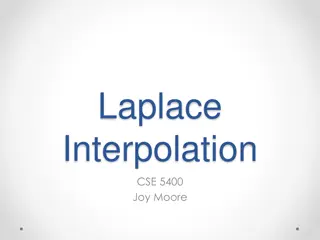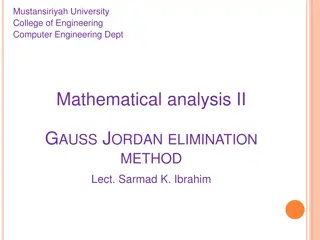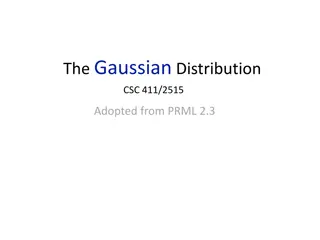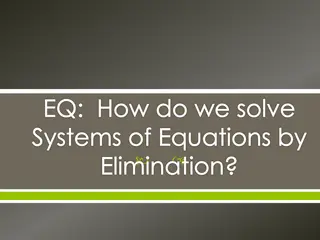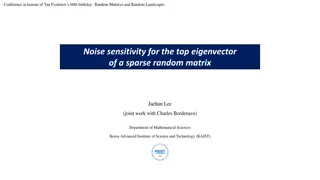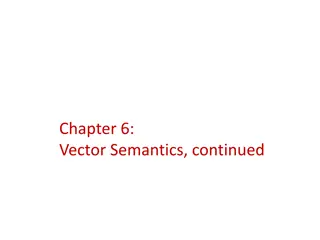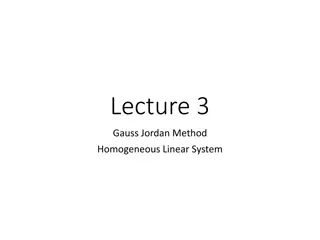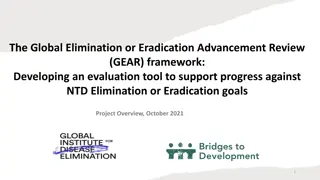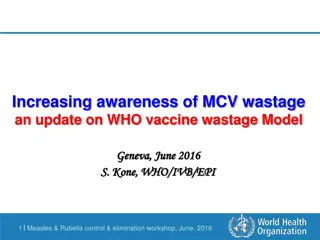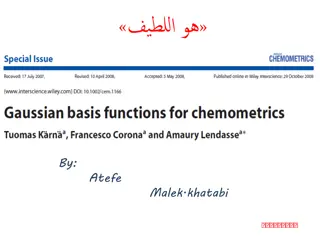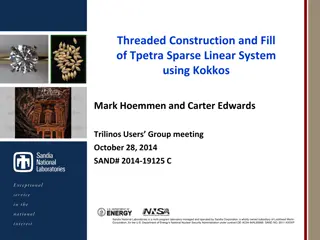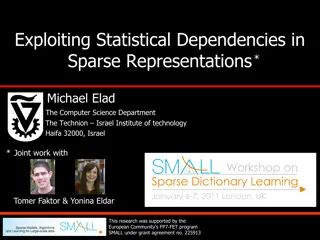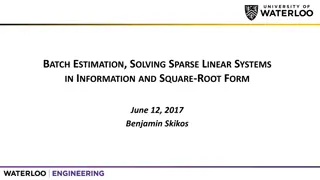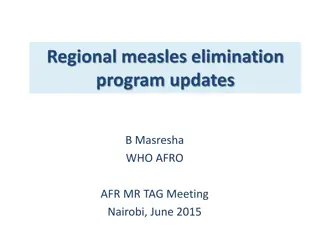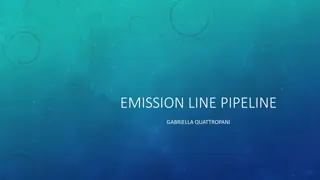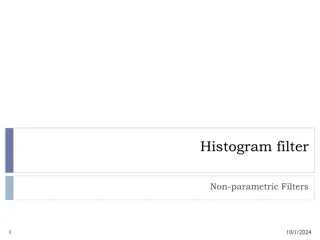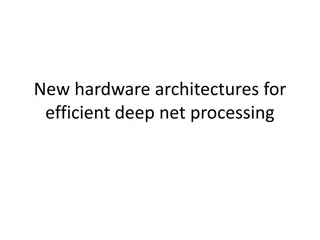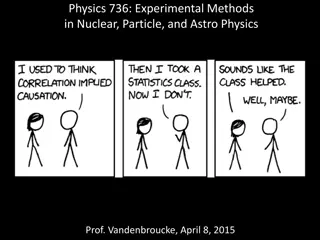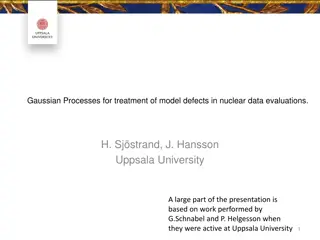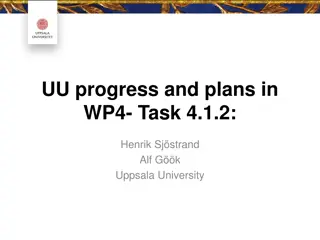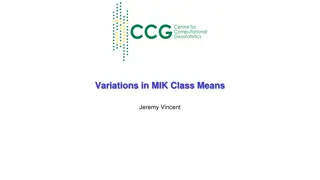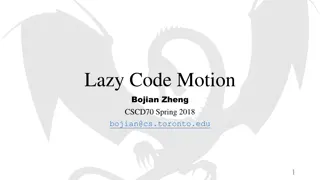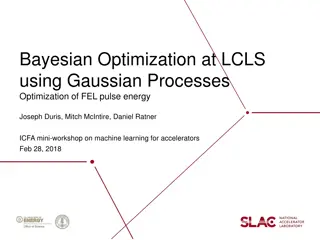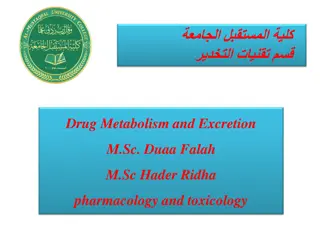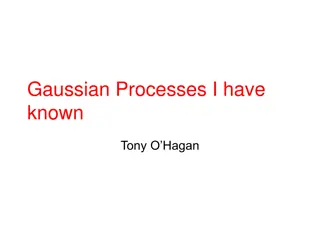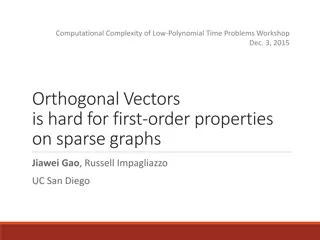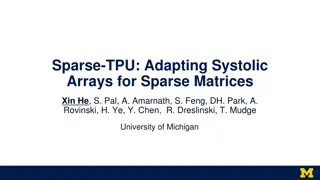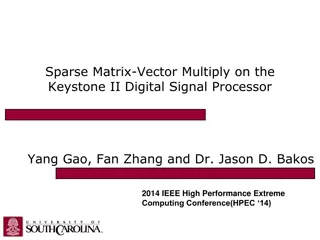Laplace Interpolation for Sparse Data Restoration
Laplace Interpolation is a method used in CSE 5400 by Joy Moore for interpolating sparse data points. It involves concepts such as the mean value property, handling boundary conditions, and using the A-times method. The process replaces missing data points with a designated value and approximates in
2 views • 13 slides
Unraveling the Gaussian Copula Model and the Financial Collapse of 2008
Explore the dangers of relying on the Gaussian copula model for pricing risks in the financial world, leading to the catastrophic collapse of 2008. Discover how the lure of profits overshadowed warnings about the model's limitations, causing trillions of dollars in losses and threatening the global
7 views • 18 slides
Gaussian Elimination Method in Linear Algebra
Gaussian Elimination and Gauss-Jordan Elimination are methods used in linear algebra to transform matrices into reduced row echelon form. Wilhelm Jordan and Clasen independently described Gauss-Jordan elimination in 1887. The process involves converting equations into augmented matrices, performing
4 views • 14 slides
The Gaussian Distribution and Its Properties
This insightful content dives into the Gaussian Distribution, including its formulation for multidimensional vectors, properties, conditional laws, and examples. Explore topics like Mahalanobis distance, covariance matrix, elliptical surfaces, and the Gaussian distribution as a Gaussian function. Di
0 views • 19 slides
Solving Systems of Equations by Elimination
Learn how to solve systems of equations by elimination method through examples, warm-up exercises, steps for elimination, and practice problems. Master this technique to find the unique values that make the equations true. Get ready to enhance your algebra skills with step-by-step guidance and visua
0 views • 13 slides
Maintaining Maternal & Neonatal Tetanus Elimination: Post-validation Assessment in Country X
This post-validation assessment report delves into the efforts to maintain Maternal & Neonatal Tetanus Elimination in Country X. It includes findings from field assessments, recommendations for sustaining the elimination status, and the critical role of surveillance in addressing vulnerable populati
3 views • 19 slides
Comprehensive Overview of Numerical Linear Algebra Methods for Solving Linear Systems
Explore numerical linear algebra techniques for solving linear systems of equations, including direct and iterative methods. Delve into topics like Gaussian elimination, LU factorization, band solvers, sparse solvers, iterative techniques, and more. Gain insights into basic iterative methods, error
6 views • 12 slides
Noise Sensitivity in Sparse Random Matrix's Top Eigenvector Analysis
Understanding the noise sensitivity of the top eigenvector in sparse random matrices through resampling procedures, exploring the threshold phenomenon and related works. Results highlight the impact of noise on the eigenvector's stability and reliability in statistical analysis.
0 views • 7 slides
Sparse vs. Dense Vector Representations in Natural Language Processing
Tf-idf and PPMI are sparse representations, while alternative dense vectors offer shorter lengths with non-zero elements. Dense vectors may generalize better and capture synonymy effectively compared to sparse ones. Learn about dense embeddings like Word2vec, Fasttext, and Glove, which provide effic
0 views • 44 slides
Overview of Sparse Linear Solvers and Gaussian Elimination
Exploring Sparse Linear Solvers and Gaussian Elimination methods in solving systems of linear equations, emphasizing strategies, numerical stability considerations, and the unique approach of Sparse Gaussian Elimination. Topics include iterative and direct methods, factorization, matrix-vector multi
0 views • 35 slides
Gaussian Elimination and Homogeneous Linear Systems
Gaussian Elimination is a powerful method used to solve systems of linear equations. It involves transforming augmented matrices through row operations to simplify and find solutions. Homogeneous linear systems have consistent solutions, including the trivial solution. This method is essential in li
0 views • 16 slides
Developing GEAR Framework for NTD Elimination Progress Evaluation
Designing an evaluation framework for NTD elimination progress, the Global Elimination or Eradication Advancement Review (GEAR) aims to enhance efficiency and effectiveness. The project involves stakeholder engagement, pilot design, and tool refinement within a structured timeline for strategic impr
0 views • 12 slides
The Impact of Vaccine Wastage on Measles Elimination Efforts
This presentation focuses on the significance of vaccine wastage in the context of measles elimination, emphasizing the factors influencing wastage, why it matters for achieving high vaccination coverage, and tools for estimating wastage. The content highlights the challenges posed by wastage on vac
0 views • 13 slides
Dynamic Load Balancing in Block-Sparse Tensor Contractions
This paper discusses load balancing algorithms for block-sparse tensor contractions, focusing on dynamic load balancing challenges and implementation strategies. It explores the use of Global Arrays (GA), performance experiments, Inspector/Executor design, and dynamic buckets implementation to optim
1 views • 32 slides
Functional Approximation Using Gaussian Basis Functions for Dimensionality Reduction
This paper proposes a method for dimensionality reduction based on functional approximation using Gaussian basis functions. Nonlinear Gauss weights are utilized to train a least squares support vector machine (LS-SVM) model, with further variable selection using forward-backward methodology. The met
0 views • 23 slides
Accelerating Progress Against NTD Elimination: GEAR Evaluation Tool Discussion
Discussion draft for the Global Elimination or Eradication Acceleration Review (GEAR) focusing on evaluating progress against NTD elimination goals, specifically oncho outcomes. The draft covers findings, expert meeting goals, GEAR process overview, and strategic lessons for effectively presenting r
0 views • 13 slides
Gaussian Statistics and Confidence Intervals in Population Sampling
Explore Gaussian statistics in population sampling scenarios, understanding Z-based limit testing and confidence intervals. Learn about statistical tests such as F-tests and t-tests through practical examples like fish weight and cholesterol level measurements. Master the calculation of confidence i
0 views • 8 slides
Threaded Construction and Fill of Tpetra Sparse Linear System Using Kokkos
Tpetra, a parallel sparse linear algebra library, provides advantages like solving problems with over 2 billion unknowns and performance portability. The fill process in Tpetra was not thread-scalable, but it is being addressed using the Kokkos programming model. By utilizing Kokkos data structures
0 views • 19 slides
Fast High-Dimensional Filtering and Inference in Fully-Connected CRF
This work discusses fast high-dimensional filtering techniques in Fully-Connected Conditional Random Fields (CRF) through methods like Gaussian filtering, bilateral filtering, and the use of permutohedral lattice. It explores efficient inference in CRFs with Gaussian edge potentials and accelerated
0 views • 25 slides
Statistical Dependencies in Sparse Representations: Exploitation & Applications
Explore how to exploit statistical dependencies in sparse representations through joint work by Michael Elad, Tomer Faktor, and Yonina Eldar. The research delves into practical pursuit algorithms using the Boltzmann Machine, highlighting motivations, basics, and practical steps for adaptive recovery
0 views • 47 slides
Efficient Coherence Tracking in Many-core Systems Using Sparse Directories
This research focuses on utilizing tiny, sparse directories for efficient coherence tracking in many-core systems. By optimizing directory entries and leveraging sharing patterns, the proposed approach achieves high performance with minimal on-chip area investment. Results demonstrate significant en
0 views • 66 slides
Communication Costs in Distributed Sparse Tensor Factorization on Multi-GPU Systems
This research paper presented an evaluation of communication costs for distributed sparse tensor factorization on multi-GPU systems. It discussed the background of tensors, tensor factorization methods like CP-ALS, and communication requirements in RefacTo. The motivation highlighted the dominance o
1 views • 34 slides
Batch Estimation and Solving Sparse Linear Systems
Explore the concepts of batch estimation, solving sparse linear systems, and Square Root Filters in the context of information and square-root form. Learn about extended information filters, information filter motion updates, measurement updates, factor graph optimization, and more. Understand how S
0 views • 37 slides
Progress Towards Measles Elimination in the African Region
The data presented showcases the progress and goals of measles elimination efforts in the African Region, focusing on targets for routine immunization coverage, introduction of MCV1 and MCV2 vaccines, supplementary immunization activities (SIAs), surveillance performance, and overall advancements to
0 views • 26 slides
Advanced Emission Line Pipeline for Stellar Kinematics Analysis
This comprehensive pipeline includes processes for stellar kinematics, continuum fitting, Gaussian line fitting, and analysis of SAMI-like cubes. It also covers Gaussian fitting techniques, parameter mapping, and potential issues. The pipeline features detailed steps and strategies for accurate anal
0 views • 10 slides
Robot Localization Using Kalman Filters
Robot localization in a hallway is achieved through Kalman-like filters that use sensor data to estimate the robot's position based on a map of the environment. This process involves incorporating measurements, updating state estimates, and relying on Gaussian assumptions for accuracy. The robot's u
0 views • 26 slides
Efficient Hardware Architectures for Deep Neural Network Processing
Discover new hardware architectures designed for efficient deep neural network processing, including SCNN accelerators for compressed-sparse Convolutional Neural Networks. Learn about convolution operations, memory size versus access energy, dataflow decisions for reuse, and Planar Tiled-Input Stati
0 views • 23 slides
Statistical Distributions in Physics
Exploring the connections between binomial, Poisson, and Gaussian distributions, this material delves into probabilities, change of variables, and cumulative distribution functions within the context of experimental methods in nuclear, particle, and astro physics. Gain insights into key concepts, su
0 views • 13 slides
Starting a Hepatitis C Elimination Program at Lummi
Learn about the Hepatitis C elimination program at Lummi Tribal Health Center, focusing on defining elimination, required interventions for HCV elimination, and the Lummi program's description. The activity offers 7 contact hours upon completion. No conflicts of interest are present, and the event i
1 views • 24 slides
Gaussian Processes for Treatment of Model Defects in Nuclear Data Evaluations
Gaussian Processes (GP) are explored for treating model defects in nuclear data evaluations. The presentation discusses the impact of model defects on evaluation results and proposes using GP to address these issues. The concept of GP and its application in treating model defects are detailed, highl
0 views • 28 slides
Enhancing Nuclear Data Evaluation with Gaussian Processes
Uppsala University is investing efforts in developing the TENDL methodology to incorporate model defect methods for nuclear data evaluations. By leveraging Gaussian Processes and Levenberg-Marquardt algorithm, they aim to improve the accuracy and reliability of calibration data to produce justified
0 views • 16 slides
Analyzing Variations in MIK Class Means by Jeremy Vincent
The presentation delves into the MIK estimator, exploring its impact on estimation with constant class means and non-Gaussian data. Review of initial results, examination of class mean bias in upper tail, and implications for metal containment are discussed. Cross-validation study findings, future w
0 views • 9 slides
Lazy Code Motion and Partial Redundancy Elimination in Optimizing Compiler
Lazy code motion, partial redundancy elimination, common subexpression elimination, and loop invariant code motion are optimization techniques used in compilers to improve code efficiency by eliminating redundant computations and moving code blocks to optimize performance. These techniques aim to de
0 views • 35 slides
Bayesian Optimization at LCLS Using Gaussian Processes
Bayesian optimization is being used at LCLS to tune the Free Electron Laser (FEL) pulse energy efficiently. The current approach involves a tradeoff between human optimization and numerical optimization methods, with Gaussian processes providing a probabilistic model for tuning strategies. Prior mea
0 views • 16 slides
Drug Metabolism and Excretion in Pharmacology
Drug metabolism involves the biotransformation of pharmaceutical substances in the body, primarily in the liver, to facilitate their elimination. This process helps convert drugs into less active forms for enhanced elimination through various reactions in Phase I and Phase II metabolism. Factors suc
0 views • 20 slides
Gaussian Processes: A Comprehensive Overview
Gaussian Processes (GPs) have wide applications in statistics and machine learning, encompassing regression, spatial interpolation, uncertainty quantification, and more. This content delves into the nature of GPs, their use in different communities, modeling mean and covariance, as well as the nuanc
0 views • 50 slides
Orthogonal Vectors Conjecture and Sparse Graph Properties Workshop
Exploring the computational complexity of low-polynomial-time problems, this workshop delves into the Orthogonal Vectors Problem and its conjectures. It introduces concepts like the Sparse OV Problem, first-order graph properties, and model checking in graphs. Discussing the hardness of problems rel
2 views • 22 slides
Reservoir Modeling Using Gaussian Mixture Models
In the field of reservoir modeling, Gaussian mixture models offer a powerful approach to estimating rock properties such as porosity, sand/clay content, and saturations using seismic data. This analytical solution of the Bayesian linear inverse problem provides insights into modeling reservoir prope
0 views • 10 slides
Sparse-TPU: Adapting Systolic Arrays for Sparse Matrices
This paper explores Sparse-TPU, a novel approach that modifies systolic arrays to efficiently handle sparse matrix workloads, achieving significant speedup and energy savings compared to traditional TPUs. The content delves into matrix packing, dataflow, PE design, and algorithm optimization within
0 views • 27 slides
Sparse Matrix-Vector Multiply on Keystone II DSP
Sparse matrix-vector multiplication on the Keystone II Digital Signal Processor (DSP) is explored in this research presented at the IEEE High Performance Extreme Computing Conference. The study delves into the hardware features of the Keystone II platform, including its VLIW processor architecture a
0 views • 20 slides
